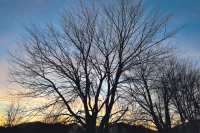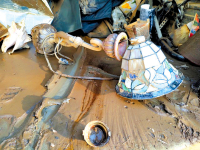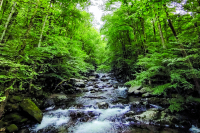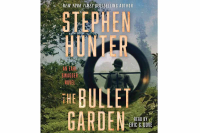Peeling back the layers: Couple shares Cherokee history, culture
With over 50 years of experience in each of their disciplines, award-winning artisan couple Butch and Louise Goings continuously garner attention with their expertise in Cherokee basket making and wood carving.
WCU library sharpens focus on regional history with two new websites
Individuals with an interest in the region’s past can now search two new online archives devoted to Cherokee culture and the evolution of travel in Western North Carolina.
Both sites are maintained courtesy of Western Carolina University’s Hunter Library.
“Travel Western North Carolina” includes images and commentary about 27 towns and communities in WNC over five decades. The site allows users to follow a route along footpaths and wagon trails in the 1890s, take a train ride in the 1910s, and drive by car along mountain roads in the 1930s.
Each “stop” includes a description of the community and excerpts from primary documents of the time, including newspapers, letters and guides. The site is online at www.wcu.edu/library/DigitalCollections/TravelWNC.
“Cherokee Traditions: From the Hands of Our Elders” unites information about Cherokee basketry, pottery, woodworking and more and includes information about artisans and archival photos. The “From the Hands of Our Elders” pages grew from a grant-funded, multi-institutional project that also saw the creation of two guides to Cherokee basketry and pottery. The site is online at www.wcu.edu/library/DigitalCollections/CherokeeTraditions.
Photographs and documents from the sites are accessible by searchable databases, making rare and unique research materials accessible to students, researchers, teachers and the public. Both new collections formerly were elements within Hunter Library’s “Craft Revival: Shaping Western North Carolina Past and Present” website, a research-based site that documents an effort to revive handcraft in the western region of the state in the late 19th and early 20th centuries.
Anna Fariello, an associate research professor who headed the craft revival site’s creation and development, was responsible for generating much of the content in the “Cherokee Traditions” pages.
“I think this will be especially helpful to our students and researchers who want to look at authentic Cherokee material,” Fariello said. “The way I built this site, perhaps it could be added onto. It has the capacity to be expanded to include some of the other aspects of Cherokee culture that are focuses of WCU’s Cherokee Studies Program.”
Pages in the “Travel Western North Carolina” site – originally intended as context for the craft revival site – were created through research by George Frizzell, head of special collections, and illustrated with special collections documents. Frizzell wants visitors to the site to come away with an understanding that the WNC region changes and adapts like any other.
“I hope it shows people that this area changed with the arrival of new technologies, and that with the arrival of the railroad and automobile, the infrastructure was revised and revamped, and people acknowledged the impact on the economy,” he said.
Digitizing information serves a number of purposes, said Mark Stoffan, head of digital, access and technology services for WCU’s Hunter Library. Statistics show that the library’s digital collections are accessed by users from around the world. Increased digitization opens information to a broader audience. Digitization can help publicize collections – sometimes prompting gifts of similar materials – and helps protect originals from handling.
For more information about the new digital collections at WCU, call Fariello at 828.227-2499 or email her at This email address is being protected from spambots. You need JavaScript enabled to view it.. For a list of all Hunter Library’s digital collections, go online to www.wcu.edu/library/DigitalCollections.
Watershed group aids Cherokee basketmakers
As clay is to the potter and stone is to the sculptor, river cane is the vital raw material to the Cherokee basketmaker. But it’s in short supply.
The Watershed Association of the Tuckasegee River has received a grant from a Cherokee artisans group for $9,500 to locate cane stands along the river to provide a local supply source for basketmakers.
Roger Clapp, WATR director, has issued a call for volunteers to help with the river cane hunt, which will run through September 2012.
With a revival of basketmaking in Cherokee, artisans are having to travel farther and farther from home to find cane suitable for their use, said David Cozzo, director of Revitalization of Traditional Cherokee Artisan Resources, which provided the grant.
It wasn’t long ago, said Cozzo, that the art of basketmaking had gone into decline to the point that there were only two Cherokee artisans making double-weave baskets. Supply of cane wasn’t a problem.
Then the Cherokee Preservation Foundation stepped in and started basketweaving classes. A revival ensued. Now, the craft is even taught in the Cherokee High School.
“With the cultural revival, the need for river cane has increased,” said Cozzo. His group is planning a trip soon to Kentucky to harvest cane from a “really nice stand” there. And the group is working with Sumter National Forest in South Carolina to find cane there for harvesting.
Cozzo is convinced that there is river cane enough in Jackson and Swain counties to provide an adequate local source — it just needs to be located and the owners persuaded to allow the harvesting.
Volunteers or owners of rivercane stands should contact the WATR office in Bryson City at 828.488.8418.
WATR meets Nov. 7
The fall meeting of Watershed Association of the Tuckasegee River is set for 7 p.m. Monday, Nov. 7, in the atrium of the new Jackson County Library. Refreshments will be served at 6:30 p.m. Dan Perlmutter, a retired Western Carolina University professor, will discuss the proposed Watershed Activity and Discovery Science Center.
RTCAR: Enabling artisans to preserve tradition
In the storefront of Qualla Arts and Crafts Mutual, shelves and tables are laden with handmade baskets that shimmer dully with a multitude of brown hues. From deep walnut umber to the blanched eggshell of white oak and the glinting toasted saffron of maple strips bent into tiny, v-shaped curves, these baskets represent a brilliant array of every brown, tan and cream imaginable.
But they also represent generations of knowledge and craftsmanship passed down within the Eastern Band of Cherokee Indians from parent to child, master craftsman to student.
And while the knowledge and practice lives on and thrives on the boundary, the plants and trees vital to maintaining the art are becoming increasingly scarce, dying out and being ravaged by the blight of insects and encroaching development.
Just across the Oconaluftee River, Butch and Louise Goings are sitting at a plastic table in the Cherokee Reservation Extension Office, talking about the craft. They have been seeking out basket-quality white oaks for years, and Butch Goings says he’s long noticed the viable trees thinning out.
“The white oak is really getting scarce,” he says.
He has now harvested unsuitable trees his basket maker mother-in-law passed up years ago because ideal trees started becoming difficult to find. Goings is sporting a red pullover and clutching a white coffee cup, smiling faintly as he jokes with his wife about his role in the basket-making process. He is a wood carver, chiefly, and it is his wife Louise who is the real basket maker. He’s never minded gathering and chopping the white oaks saplings that make his wife’s baskets, but that’s as far as he goes, he jokes. Louise Goings, is, he says, particular about her splits. She likes to do them herself.
She laughs but does not disagree. She likes things the way she likes them, and even on the splits she doesn’t cut herself she still likes to clean them up a little bit.
She learned the craft from her mother, who took Goings and her siblings out into the woods to look for straight, high-limbed white oaks. Back then, Goings says, you could gather virtually anywhere without fear of confrontation. Today, she and her husband don’t seek out their own white oaks, partially because of their scarcity and partly because of the changing social climate.
“Boundaries became more permanent, “ Goings says, explaining what has changed since her childhood. “Back when my mother grew up and when I grew up, you could go on your neighbor’s land and look.”
Not so today. Over the last few decades, land ownership has become more concrete and the hallmarks of modern progress have taken their toll on traditional basket-making resources. River cane, which is the oldest Cherokee basket-making material, fell to agricultural land clearing and dam building, while the white oak has been lost to land development as well as the restrictions that comes with an increasingly privatized view of land ownership.
Louise Goings now relies on a supplier, named only as James, who has his own mysterious ways of finding good material in the limited stands of white oak that are left. It also probably helps that he likely has special relationships with an array of private landowners and organizations like the U.S. Forest Service that would be hard for individual basket makers to cultivate.
James, Louise Going says, knows and supplies virtually all of the white oak basket makers on the Qualla Boundaries, though he is a relatively elusive presence. David Cozzo jokes that, in his six-and-a-half years working with Cherokee artisans, even he’s never met James.
Cozzo is the project director at the Revitalization of Traditional Cherokee Artisan Resources. It’s a long name that stands for a simple goal — saving the source materials that will keep the traditional arts alive.
RTCAR started in 2004 to combat the swift depletion of resources such as river cane and white oak by pulling in grant funding to help protect the plants that are left as well as trying to reintroduce them into the environment and encourage them to grow in new spaces.
They’ve found partners in existing environmental protection groups like the Hiwassee River Watershed Coalition and the Land Trust for the Little Tennessee. These conservation organizations were already working to guard species like river cane that are natural water filters and, when planted at the river’s edge, create what ecologists call a riparian buffer that protects water from the assaults made on it by land runoff.
RTCAR gives them an extra incentive — and extra money — to double their efforts.
“We bring a cultural reason,” says Cozzo. “Folks here need it. It’s not just about a place, it’s about a history. A lot of people are getting excited about [river cane] now because it’s also got a strong ecological value.”
Callie Moore is one of those people. She heads up the Hiwassee River Watershed Coalition, which, much as their name suggests, is active in restoring and maintaining healthy creeks and rivers in the watershed. It started working with RTCAR and, last year, launched a pilot project to grow a new stand of river cane. It was a relatively ambitious project because, while they conserve a lot of existing cane breaks, cultivating a completely new brake is pretty uncharted territory.
That’s because, although it’s useful for the arts and the health of waterways, river cane isn’t exactly a commonly cultivated plant. You can’t eat it, you can’t build with it, it grows on arable land but it’s not exactly a crop – in essence, no one has ever documented how or why it grows or experimented with intentional cultivation.
So, Moore says, they did a lot of research and got a wildly varying degree of advice from a range of experts, some more complicated than others. One expert said he’d done it, but then proceeded to describe an arduous process including soaking the plants’ roots and hanging them in bags, among other things.
In the end, they settled on the advice of one of the landowners they already worked with in their conservation project. His land boasts one of the highest quality cane breaks in the area, and he told Moore and her staff that his octogenarian grandmother used to plant river cane all the time. It just needs to be done in the rain.
Seeing nothing to lose in the situation, they tried it and, to their delight, it seems to be working.
“We watered it,” says Moore, “because that’s the big thing that everybody’s been saying, ‘you’ve got to keep it wet.’”
Although it initially seemed like a failure — the plants looked as though they were dying — they’ve since begun sprouting like mad. Moore is delighted, but says there was no secret to the success.
“We didn’t do anything special. We had no ceremony. We had no secret ingredient,” Moore says, but they’re hoping they can repeat the feat.
Another large front in the battle to save river cane for artisans is just access. There are a lot of healthy cane breaks within easy reach of the Qualla Boundary, but not many landowners would be open to artisans arriving unannounced and harvesting the plants. That’s where groups like Moore’s can step in and serve as a go-between for the weavers with the landowners that they already know well and work with. Since they started approaching locals several years ago, they’ve been able to gain access to a good percentage of the river cane that they know of in the area.
Elsewhere in the region, RTCAR is working with the Land Trust for the Little Tennessee, doing much the same thing. LTLT actually owns a substantial amount of land that has river cane growing on it, and it has signed a memorandum of understanding with the artists for harvesting. They’ve also gotten three rounds of grant funding through RTCAR to keep their cane healthy and thriving, although it’s a fraction of what used to cover the area.
“These cane breaks that used to cover hundreds of acres are down to about 1 percent of their former extent,” said Dennis Desmond, the land stewardship director for LTLT, which is why the groups are so keen to keep what they’ve got.
Not all of RTCAR’s partner efforts have been such triumphs, though. Back at the Extension Office, Butch Goings crosses his arms and laughs wryly when Cozzo mentions their efforts at growing white oaks for basket making. To give some exposition to this inside joke, Cozzo disappears into his office and returns with a photo of a field of PVC pipes planted like trees among tangles of branches at their roots.
He explains that the idea was to cultivate the perfect basket tree – as straight as possible with branches starting as high on the trunk as possible, because branch structure reaches to the heart of the tree and beyond the first branch, the wood is unusable. The concept was a good one: grow the saplings in pipes to maintain the vertical integrity and prevent branches from developing.
But the result was a bit of a disaster.
“They grew too fast,” explains Beth Ross Johnson, a community development specialist with RTCAR. “The wood was really stringy is what everybody said.”
So now they’re looking for alternative methods to save and grow the white oak population, though, Cozzo muses with a laugh, it wasn’t a total loss. They’ve got a great source of firewood for the winter.
After trying their own campaigns with mixed success, RTCAR this year decided to reach out to artisans from other traditions whose art and source material were also fading away. What were they doing to hold onto their traditions? And was it working?
So in mid-November, they invited speakers from around the country to a symposium designed to open dialogue about salvaging waning traditional arts and resources.
They spoke with sweetgrass basket makers from South Carolina who have seen some success in their public campaign to save the coastal grasses and heard from other Native American tribal artists about their plights.
Kelly Church, a fifth-generation black ash basket maker from Michigan’s Grand Traverse Band of Ottawa and Chippewa, told of her tribe’s fight against the Emerald Ash Borer, an insect that is threatening to eliminate the species entirely. She’s pursuing a seed-saving crusade and shooting videos of artisans at their trade, in case the tree — and with it the art — die out entirely and have to be regenerated in the future.
In Cherokee, artisans like Louise Goings aren’t as concerned about losing the knowledge, mostly because they’re actively guarding against it with in-school programs and in-home instruction by individual craftsmen.
Her own son, she says, is a talented basket maker. Although he isn’t pursuing it as a career or even a regular hobby, he kept up with it, even as a teenager, she jokes, because he realized quickly that baskets equal money.
“They do it whenever they think they need a dollar,” Goings jokes of her children, but says she hopes they keep the tradition alive. And she’s confident they will. She herself started weaving baskets at the tender age of nine, and although she grew bored of it as a teenager, she came back to the craft in her early 20s and has been weaving ever since.
And the folks at RTCAR realize that maintaining this knowledge is the other key component in keeping traditional Cherokee arts alive.
“You can save all the material you want,” says Cozzo, “but if people don’t know how to use it, you’re just doing plant preservation.”
Which is why the knowledge of artisans like Louise Goings is so vital in making sure that the efforts of RTCAR and others aren’t just preserving plants, they’re preserving arts, history and culture that can’t be replaced.
New book takes closer look at baskets and their makers
Anna Fariello believes that artifacts — somewhat like windows — can act as passageways to a culture’s soul.
“Material culture can be a window onto the changes that occur in social and cultural history,” said Fariello, an associate professor and chief architect of the Craft Revival Project at Western Carolina University’s Hunter Library.
An author, editor and former research fellow at the Smithsonian Museum of American Art, Fariello most recently turned her attention to Cherokee basketry, a thousands-year-old tradition, passed from mother to daughter, that she believes is integral to Cherokee culture.
Fariello’s new book, titled Cherokee Basketry: From the Hands of our Elders, studies Cherokee baskets and basket-makers who lived during the first half of the 20th century.
The project reinforced Fariello’s understanding that for Cherokee people, “the making of things is significant to their culture and their identity,” a concept foreign to many people in contemporary, mainstream culture, she said. The Cherokees’ use of natural resources as basket materials gave Fariello an appreciation of the environmental sustainability and ecological balance also inherent in the culture.
The Eastern Band of Cherokee Indians played a significant role in the craft revival, a regional movement in the late 19th and early 20th centuries that produced a wealth of objects, identified traditional skills, and revitalized handwork production in Western North Carolina.
With a grant from the State Library of North Carolina, Fariello originally set out to expand the information available on the project’s site, which chronicles the movement and its impact on Western North Carolina through text and images.
Fariello worked with the Qualla Arts and Crafts Mutual and the Museum of the Cherokee Indian in Cherokee with the purpose of making their collections available online.
A grant of $47,000 from the Cherokee Preservation Foundation added a second element to the project: to research and more fully document basketry in those collections.
While the project did not start out as a book, Fariello said it seemed the logical conclusion. “The book takes scattered elements and arranges them for a more complete picture,” she said.
Cherokee Basketry examines specifics about basket-makers themselves, how baskets were made, and what they were used for. Archival photographs illustrate “Cherokee Basketry,” published by The History Press of Charleston, S.C.
“I hope that this book has a broad audience,” Fariello said. “I think it can serve as a classroom text for Cherokee studies or the visual arts, and I also think it will have a broad public appeal for anyone interested in regional culture, especially the influence of the Cherokees on Western North Carolina.”
Fariello presented books to Eastern Band of Cherokee Indians Chief Michell Hicks and the Tribal Council. Fariello also gave 200 copies of the book to Cherokee School Superintendent Joyce Dugan for teachers to use in the Eastern Band’s new K-12 school.
The project was a great service to the Qualla Arts and Crafts Mutual, whose permanent collection has more than 100 baskets and continues to grow.
“Before the archive organization, the only recorded information in our permanent collection was a handwritten line about each item,” said Vicki Cruz, manager of the Qualla Arts and Crafts Mutual.
Now the co-op’s archives are digitized and include contemporary photos, as well as information about dimensions, materials and patterns, and the artists themselves.
Fariello also worked with co-op employees on the care and display of the baskets, and about recordkeeping when a new piece enters the collection.
Cruz said she eventually plans to use her new knowledge to document the work of contemporary basket-makers. “The daughters of basket-makers Agnes Welch and Eva Wolfe, they’re basket-makers too, and now their daughters are starting to weave,” she said.
The basketry book is the first in the “From the Hands of our Elders” series, a three-year project to document Cherokee arts.
The next book, funded with $87,770 from the Cherokee Preservation Foundation, will focus on Cherokee potters and pottery during the first part of the 20th century. A book on Cherokee woodcarving and mask making is scheduled to follow.
For more information about the “From the Hands of our Elders” series or the Craft Revival Web site, contact Fariello at 828.227.2499 or This email address is being protected from spambots. You need JavaScript enabled to view it..
Preserving tradition Non-profit grows plants for Cherokee artisans
By Julia Merchant • Staff Writer
Not too long ago, the number of people who carried on the ancient Cherokee basket-weaving tradition had dwindled to just a handful. Today, the craft is experiencing a resurgence — thanks in part to local organizations helping to restore native plants vital to making the baskets.













